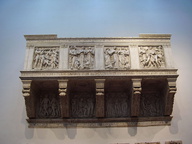Guido Reni a Roma. Il sacro e la natura

Dal 1 March 2022 al 22 May 2022
Roma
Luogo: Galleria Borghese
Indirizzo: Piazzale Scipione Borghese 5
Orari: dal martedì alla domenica. Dalle 9.00 alle 19.00. Ultimo ingresso alle ore 17.45
Curatori: Francesca Cappelletti
Costo del biglietto: INTERO € 13,00 (ultimo turno € 8,00), RIDOTTO 18-25 anni € 2,00, PRENOTAZIONE OBBLIGATORIA € 2,00. Con la volontà di consentire il maggior accesso possibile alla mostra e di sostenere i consumi culturali, la direzione della Galleria Borghese ha scelto di non applicare maggiorazioni sul costo del biglietto, che rimarrà pertanto invariato e permetterà l’accesso alla mostra e alla collezione permanente
Telefono per informazioni: +39 068413979
E-Mail info: ga-bor@beniculturali.it
Sito ufficiale: http://galleriaborghese.beniculturali.it
La mostra ruota attorno al ritrovato dipinto di Reni Danza campestre (1605 circa), che da un anno è tornato a fare parte della collezione del museo. Appartenente alla collezione del cardinale Scipione Borghese, citato negli antichi inventari sin dall’inizio del Seicento, venduto nell’Ottocento, prima disperso, e poi ricomparso nel 2008 sul mercato antiquario londinese come anonimo bolognese, il quadro, dopo le opportune verifiche attributive, è stato riacquistato dalla Galleria nel 2020. Oltre a rappresentare un’importante integrazione storica del patrimonio del museo, la sua presenza nelle sale della pinacoteca accanto agli altri dipinti della collezione sottolinea la fondamentale importanza della committenza Borghese per Guido Reni e offre l’opportunità di riflettere sul rapporto del pittore con il soggetto campestre e la pittura di paesaggio, finora ritenuti “estranei” alla sua produzione.
Guido Reni a Roma. Il Sacro e la Natura attraverso l’esposizione di oltre 30 opere, prova a ricostruire – partendo dall’interesse di Reni per la pittura di paesaggio in rapporto ad altri pittori operanti a Roma nel primo Seicento – i primi anni del soggiorno romano dell’artista, il suo studio appassionato dell’antico e del Rinascimento, lo stordimento rispetto alla pittura di Caravaggio da lui conosciuto e frequentato, e i rapporti con i suoi committenti.
LA MOSTRA
Il percorso di mostra si apre al piano terra nel grande salone d’ingresso con 4 monumentali pale d’altare – la Crocifissione di San Pietro (1604-5), la Trinità con la Madonna di Loreto e il committente cardinale Antonio Maria Gallo (1603-4 c.a), il Martirio di Santa Caterina d'Alessandria (1606 c.a) e il Martirio di Santa Cecilia (1601) – che evidenziano la capacità dell’artista, maturata già negli anni precedenti all’arrivo a Roma, di confrontarsi con questa tipologia, di toccare gli animi attraverso la solennità e la potenza delle sue figure perfette, e ci rivelano molto anche del rapporto di Reni con i suoi committenti: Paolo Emilio Sfondrato, Antonio Maria Gallo, Ottavio Costa e Pietro Aldobrandini.
Nelle sale contigue opere come la Strage degli Innocenti (1611) e San Paolo rimprovera San Pietro penitente (1609 c.) confermano come alla base della pittura romana di Guido Reni, ma anche di quella che si spinge un poco più in là negli anni come con Lot e le figlie e Atalanta e Ippomene (1615-20), ci sia una forte attrazione per il mestiere degli scultori, dimostrata dalla posizione dei corpi nello spazio, dalla concretezza tridimensionale dei gesti, dalle espressioni dei volti che, magistralmente, fissano per sempre una specifica emozione.
Al primo piano, nella seconda parte della mostra, prestiti generosi e le eccezionali raccolte della Galleria consentono percorsi e divagazioni intorno al tema del paesaggio e all’ultimo acquisto della collezione, la Danza Campestre: nella Sala del Lanfranco, per sottolineare la pratica della pittura di paesaggio a Roma nel primo decennio del Seicento, sono esposte alcune delle necessarie premesse emiliane, dal Paesaggio con la caccia al cervo di Niccolò dell’Abate alla Festa campestre (1584) di Agostino Carracci, alcuni quadri di Paul Bril parte della collezione della Galleria, e Paesaggio con Arianna abbandonata e Paesaggio con Salmace ed Ermafrodito (1606- 8 c.a), due dei sei paesaggi con storie mitologiche di Carlo Saraceni, già parte della collezione Farnese, provenienti dal Museo e Real Bosco di Capodimonte. E ancora alcune tarde e letterarie sperimentazioni dei pittori bolognesi, dai quattro tondi di Francesco Albani – paesaggi eseguiti nel 1621 per Scipione Borghese e abitati da dee e ninfe – al Paesaggio con Silvia e il satiro (1615) del Domenichino proveniente dalla Pinacoteca di Bologna, testimonianza di un interesse che continua nei decenni successivi a quei primi intensi momenti del secolo.
Il percorso fra Guido Reni e i suoi contemporanei, fra paesaggio e figura, termina a Roma con l’affresco eseguito fra il 1613 e il 1614 nel casino del cardinale Scipione Borghese, oggi Pallavicini Rospigliosi. Tra gli affreschi di Paul Brill e di Antonio Tempesta, Reni immagina il sorgere del Sole, circondato dalle Ore e preceduto da Aurora, lasciando intravedere sullo sfondo un paesaggio marino che ci riporta indietro alla Danza campestre, oggi tornata nella dimora che fu di Scipione Borghese e con cui si conclude la mostra.
L’affresco, uno dei massimi capolavori dell’artista, idealmente rappresenta la fine del fruttuoso ma tormentato rapporto del pittore con la famiglia Borghese, e del suo primo, fondamentale soggiorno romano.
IL PRIMO SOGGIORNO ROMANO DI GUIDO RENI
A Roma, città di confronto e di sfide per gli artisti, il giovane Guido Reni arriva all’inizio del Seicento probabilmente invitato dal cardinale Paolo Emilio Sfondrato, conosciuto a Bologna nel 1598. Quest’ultimo, nipote di papa Gregorio XIV, visita il capoluogo emiliano al seguito di Clemente VIII, entrando in contatto con Reni, a cui chiede una copia dell’Estasi di Santa Cecilia di Raffaello. Questa versione, giunta in città, anticipa l’arrivo del suo autore che vi rimane, con frequenti interruzioni, fino al 1614. Un soggiorno contrassegnato all’inizio da una serie di lavori con soggetti religiosi, alcuni eseguiti per conto del cardinale Sfondrato che, nel 1608, vende a Scipione Borghese parte della sua collezione.
Al 1604 risale la Crocifissione di San Pietro, che segna un momento di confronto serrato con Caravaggio e di ardente sperimentazione giovanile. La tela – commissionata dal cardinale Pietro Aldobrandini per l’abbazia di San Paolo alle Tre Fontane – insieme ad altre opere come Davide con la testa di Golia (1605) rivela l’attenzione di Reni non solo per Caravaggio ma anche per i modi di altri artisti contemporanei, che rielaborati porteranno alla sua maniera singolare e ammirata di dipingere, in cui il chiaroscuro drammatico caravaggesco si innesta sulla lezione di Ludovico Carracci.
Altro momento cruciale del soggiorno romano, messo in luce dalla mostra, è il rapporto intessuto con il banchiere genovese Ottavio Costa, collezionista e committente che gioca a Roma un ruolo fondamentale, anche per l’uso spregiudicato delle copie che faceva realizzare dai suoi quadri, come il San Francesco in estasi e il San Giovanni Battista di Caravaggio. I nomi di Reni e Caravaggio si trovano appaiati, insieme a quello di Annibale Carracci, nelle carte di Costa, e tornano ad esserlo nelle considerazioni di altri personaggi di rilievo per la storia culturale di questo straordinario periodo, come il marchese Vincenzo Giustiniani.
La mostra è accompagnata da un catalogo edito da Marsilio con testi, tra gli altri, di Daniele Benati, Raffaella Morselli e Maria Cristina Terzaghi; una rilettura innovativa del lavoro del Maestro attraverso uno studio scientifico su Guido Reni come paesaggista.
SCARICA IL COMUNICATO IN PDF

-
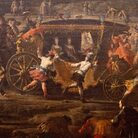 Dal 20 December 2025 al 20 April 2026
Caserta | Reggia di Caserta
Dal 20 December 2025 al 20 April 2026
Caserta | Reggia di Caserta
Regine: trame di cultura e diplomazia tra Napoli e l’Europa
-
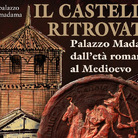 Dal 19 December 2025 al 23 March 2026
Torino | Palazzo Madama - Museo Civico d’Arte Antica
Dal 19 December 2025 al 23 March 2026
Torino | Palazzo Madama - Museo Civico d’Arte Antica
Il castello ritrovato. Palazzo Madama dall’età romana al medioevo
-
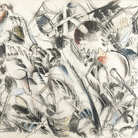 Dal 17 December 2025 al 19 January 2026
Roma | Palazzo della Cancelleria
Dal 17 December 2025 al 19 January 2026
Roma | Palazzo della Cancelleria
De Humana Mensura di Linda Karshan
-
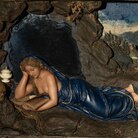 Dal 18 December 2025 al 12 April 2026
Firenze | Gallerie degli Uffizi
Dal 18 December 2025 al 12 April 2026
Firenze | Gallerie degli Uffizi
Cera una volta. Sculture dalle collezioni medicee
-
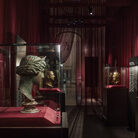 Dal 11 December 2025 al 9 April 2026
Firenze | Museo Archeologico Nazionale di Firenze
Dal 11 December 2025 al 9 April 2026
Firenze | Museo Archeologico Nazionale di Firenze
Icone di Potere e Bellezza
-
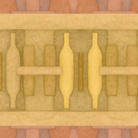 Dal 11 December 2025 al 11 January 2026
Roma | Palazzo Esposizioni Roma
Dal 11 December 2025 al 11 January 2026
Roma | Palazzo Esposizioni Roma
Giorgio Morandi nella Collezione Eni. Un viaggio attraverso la storia culturale del cane a sei zampe e l’eredità di Enrico Mattei
